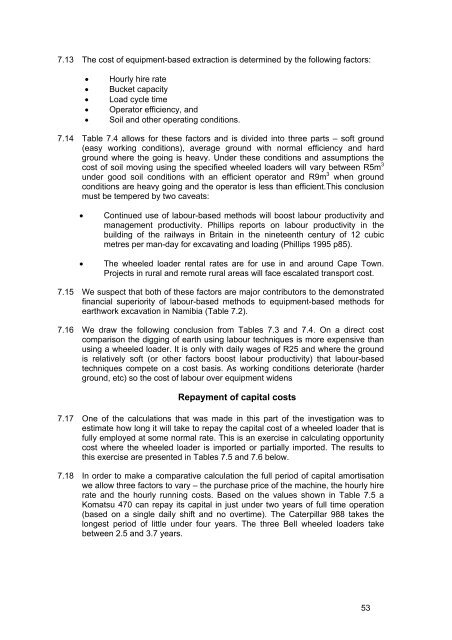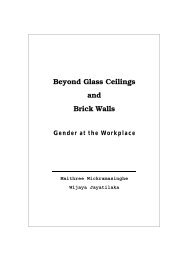SETP No. 14 The Economic Value of Incremental Employment in the ...
SETP No. 14 The Economic Value of Incremental Employment in the ...
SETP No. 14 The Economic Value of Incremental Employment in the ...
Create successful ePaper yourself
Turn your PDF publications into a flip-book with our unique Google optimized e-Paper software.
7.13 <strong>The</strong> cost <strong>of</strong> equipment-based extraction is determ<strong>in</strong>ed by <strong>the</strong> follow<strong>in</strong>g factors:<br />
• Hourly hire rate<br />
• Bucket capacity<br />
• Load cycle time<br />
• Operator efficiency, and<br />
• Soil and o<strong>the</strong>r operat<strong>in</strong>g conditions.<br />
7.<strong>14</strong> Table 7.4 allows for <strong>the</strong>se factors and is divided <strong>in</strong>to three parts – s<strong>of</strong>t ground<br />
(easy work<strong>in</strong>g conditions), average ground with normal efficiency and hard<br />
ground where <strong>the</strong> go<strong>in</strong>g is heavy. Under <strong>the</strong>se conditions and assumptions <strong>the</strong><br />
cost <strong>of</strong> soil mov<strong>in</strong>g us<strong>in</strong>g <strong>the</strong> specified wheeled loaders will vary between R5m 3<br />
under good soil conditions with an efficient operator and R9m 3 when ground<br />
conditions are heavy go<strong>in</strong>g and <strong>the</strong> operator is less than efficient.This conclusion<br />
must be tempered by two caveats:<br />
• Cont<strong>in</strong>ued use <strong>of</strong> labour-based methods will boost labour productivity and<br />
management productivity. Phillips reports on labour productivity <strong>in</strong> <strong>the</strong><br />
build<strong>in</strong>g <strong>of</strong> <strong>the</strong> railways <strong>in</strong> Brita<strong>in</strong> <strong>in</strong> <strong>the</strong> n<strong>in</strong>eteenth century <strong>of</strong> 12 cubic<br />
metres per man-day for excavat<strong>in</strong>g and load<strong>in</strong>g (Phillips 1995 p85).<br />
• <strong>The</strong> wheeled loader rental rates are for use <strong>in</strong> and around Cape Town.<br />
Projects <strong>in</strong> rural and remote rural areas will face escalated transport cost.<br />
7.15 We suspect that both <strong>of</strong> <strong>the</strong>se factors are major contributors to <strong>the</strong> demonstrated<br />
f<strong>in</strong>ancial superiority <strong>of</strong> labour-based methods to equipment-based methods for<br />
earthwork excavation <strong>in</strong> Namibia (Table 7.2).<br />
7.16 We draw <strong>the</strong> follow<strong>in</strong>g conclusion from Tables 7.3 and 7.4. On a direct cost<br />
comparison <strong>the</strong> digg<strong>in</strong>g <strong>of</strong> earth us<strong>in</strong>g labour techniques is more expensive than<br />
us<strong>in</strong>g a wheeled loader. It is only with daily wages <strong>of</strong> R25 and where <strong>the</strong> ground<br />
is relatively s<strong>of</strong>t (or o<strong>the</strong>r factors boost labour productivity) that labour-based<br />
techniques compete on a cost basis. As work<strong>in</strong>g conditions deteriorate (harder<br />
ground, etc) so <strong>the</strong> cost <strong>of</strong> labour over equipment widens<br />
Repayment <strong>of</strong> capital costs<br />
7.17 One <strong>of</strong> <strong>the</strong> calculations that was made <strong>in</strong> this part <strong>of</strong> <strong>the</strong> <strong>in</strong>vestigation was to<br />
estimate how long it will take to repay <strong>the</strong> capital cost <strong>of</strong> a wheeled loader that is<br />
fully employed at some normal rate. This is an exercise <strong>in</strong> calculat<strong>in</strong>g opportunity<br />
cost where <strong>the</strong> wheeled loader is imported or partially imported. <strong>The</strong> results to<br />
this exercise are presented <strong>in</strong> Tables 7.5 and 7.6 below.<br />
7.18 In order to make a comparative calculation <strong>the</strong> full period <strong>of</strong> capital amortisation<br />
we allow three factors to vary – <strong>the</strong> purchase price <strong>of</strong> <strong>the</strong> mach<strong>in</strong>e, <strong>the</strong> hourly hire<br />
rate and <strong>the</strong> hourly runn<strong>in</strong>g costs. Based on <strong>the</strong> values shown <strong>in</strong> Table 7.5 a<br />
Komatsu 470 can repay its capital <strong>in</strong> just under two years <strong>of</strong> full time operation<br />
(based on a s<strong>in</strong>gle daily shift and no overtime). <strong>The</strong> Caterpillar 988 takes <strong>the</strong><br />
longest period <strong>of</strong> little under four years. <strong>The</strong> three Bell wheeled loaders take<br />
between 2.5 and 3.7 years.<br />
53
















